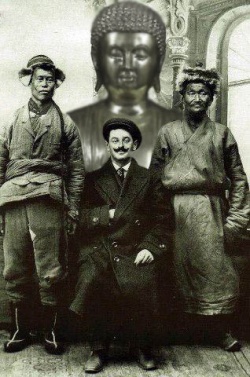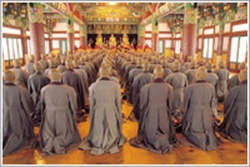Difference between revisions of "Not the Buddha’s Dharma"
m (Text replacement - "favorable " to "favorable ") |
|||
| Line 55: | Line 55: | ||
In this text, Sion, in a dozen chapters (The [[tetralemma]], Neither real nor unreal, [[Nagarjuna’s]] use of {{Wiki|dilemma}}, The subject-predicate [[relation]], [[Percepts]] and [[Wikipedia:concept|concepts]], {{Wiki|Motion}} and rest, [[Causality]], Co-dependence, [[Karmic law]], [[God]] and creation, [[Self]] or [[soul]], Self-knowledge) makes minemeat of Nagajuna’s [[principal]] arguments. No clear thinker will think much of [[Nagarjuna]] after he considers Sion’s counter-arguments. | In this text, Sion, in a dozen chapters (The [[tetralemma]], Neither real nor unreal, [[Nagarjuna’s]] use of {{Wiki|dilemma}}, The subject-predicate [[relation]], [[Percepts]] and [[Wikipedia:concept|concepts]], {{Wiki|Motion}} and rest, [[Causality]], Co-dependence, [[Karmic law]], [[God]] and creation, [[Self]] or [[soul]], Self-knowledge) makes minemeat of Nagajuna’s [[principal]] arguments. No clear thinker will think much of [[Nagarjuna]] after he considers Sion’s counter-arguments. | ||
| − | To give you an [[idea]] of how little Sion (who is | + | To give you an [[idea]] of how little Sion (who is favorable toward other schools of [[Buddhist]] [[thought]]) [[thinks]] of [[Nagarjuna’s]] [[thinking]], I’ll quote a few of his descriptions of it: “shameless {{Wiki|sophistry}},” a malicious parody of [[logic]],” “a ferocious mauling of [[logic]].” Sion acuuses [[Nagarjuna]] of “[[stealing]] [[Wikipedia:concept|concepts]] (using them while undercutting them,” “contradicting himself,” “manipulating readers in every way,” “diverting [[attention]] from controversies or outright {{Wiki|lying}},” and “begging the question (circular arguments).” |
In short, I cannot recommend “[[Buddhist]] [[Illogic]]” highly enough to anyone seriously [[interested]] in objectively considering [[Nagarjuna’s]] [[Madhyamika]] [[Buddhism]]. | In short, I cannot recommend “[[Buddhist]] [[Illogic]]” highly enough to anyone seriously [[interested]] in objectively considering [[Nagarjuna’s]] [[Madhyamika]] [[Buddhism]]. | ||
Latest revision as of 10:26, 29 January 2016
I have, at this time, written 198 Amazon book reviews, and one of the major themes in my reviews has been my distaste for Madhyamika and Prasangika-Madhyamika Buddhism. These schools of Buddhism stem from the teachings of Nagarjuna, who, next to the Buddha himself, is probably the most influential figure in Buddhism. Although many, including Ken Wilber, consider Nagarjuna a genius, I don’t. In fact, I consider him the master of illogic.
Perhaps the most popular and respected book on Nagarjuna’s teaching is Jay Garfield’s The Fundamental Wisdom of the Middle Way, Nagarjuna’a Mulamadhyamakakarika. And though very few people know about it yet, the best critique of Nagarjuna is Avi Sion’s Buddhist Illogic: A Critical Analysis of Nagarjuna’s Arguments.
Because I think it’s important for Buddhadharma students to critically examine Nagarjuna’s arguments, I am posting my reviews Garfield’s and Sion’s books.
The Perversion of Buddhism
This text, by Buddhologist Jay Garfield, provides a lengthy, in-depth Indo-Tibetan interpretation of Nagarjuna’s Mulamadhyamakalarika. Nagarjuna, the founder of the Madhyamika Middle Way of Mahayana Buddhism, is considered by many to have been a philosophical genius who elevated Gautama’s original Dharma to a higher level. But I’m not one of the many. In fact, I contend that Nagarjuna’s Middle Way is a perversion of original Buddhism, and that Nagajuna was to Gautama what Joseph Smith and John Calvin were to Jesus – a clueless perverter of the religion’s original Teaching.
I am currrently working on a book on Buddhism, and because I hadn’t read Nagarjuna in forty years (I was seriously into Madhyamika and the Prajnaparamita Sutras for a few years in the early ‘70s), I decided to bone-up by reading three texts – this one by Garfield, “ Nagarjuna’s Seventy Stanzas” by David Ross Komito (see my 2-star Amazon review), and “Buddhist Illogic,” by Avi Sion (see my forthcoming 5-star review later in July).
Before I proceed with my review of Garfield’s book, I will quote a description of Sion’s fine, inexpensive ($1.99 Kindle) text. Sion, like me, is into Aristotelian logic, and rightly finds Nagaruna an affront to the laws of logic. Here is the description:
“Sion identifies the many sophistries involved in Nagarjuna’s arguments. Nagarjuna uses double standards, applying or ignoring the Laws of thought and other norms as convenient to his goals; he manipulates his readers, by giving seemingly logical forms (like the dilemma) to his discourse, while in fact engaged in non-sequitars or appealing to doubtful premises; he plays with words, relying on unclear terminology, misleading equivocations, and unfair fixations of meaning; and he ‘steals concept” using them to deny the very percepts on which they are based.”
Because I don’t want to ape Professor Sion’s anti-Nagarjuna arguments, I’ll now present a few of my own critical argument. Know that this is just the tip of the iceberg of my criticism, and also know that because I can’t stomach Nagarjuna, I have no interest in spending an inordinate amount of time deconstructing his dense, dry, and deficient writings.
First off, Nagarjuna cannot write clearly. Anybody new to his writings will be lost without a guide like Garfield to interpret his many cryptic passages. But because Garfield is a Prasangika-Madhyamikan Buddhist professor who adores Nagarjuna, his “guidance” is hardly objective. If you want the “other side” to Nagarjuna, get Sion’s book.
Secondly, Nagarjuna is a second-rate philosopher who specializes in ridiculous statements. For example, even Garfield has to reject his absurd statement, “The identity of mover and motion; the agent and action are identical.” Here are a few more examples of his defective thinking:
“Compound phenomena are all deceptive. Therefore they are false. Whatever is deceptive is false.”
Unbeknownst to Nagarjuna, phenomena are neither true nor false, nor deceptive nor non-deceptive; they just are. The categories that Nagarjuna superimposes on phenomena are simply his own biased and deluded concepts.
“Whatever is dependently arisen, such a thing is essentially peaceful. Therefore, that which is arising itself are [sic] themselves peaceful.”
Again, Nagarjuna is guilty of superimposing his own vale-judgments on phenomena. According to his “logic,” even Hiroshima was “peaceful.”
“It is not tenable for that which depends on something else to be different from it.”
In other words, if you depend on food stamps, you’re not different from them. If you depend on the sun’s light, you’re not different from the sun.
What Nagarjuna attempts to do in this discourse is to demonstrate the emptiness of all phenomenal existents, including conditions, effects, elements, aggregates, et al. The end result, in Garfield’s words, is: “As far as analysis, one finds only dependence, relativity, and emptiness, and their dependence, relativity, and emptiness.” Beyond informing us ad nauseum that everything under the sun is dependently originated, and thereby, necessarily, essenceless or empty, Nagarjuna, the epitome of a circumscribed philosopher, has virtually nothing to say.
The Buddha didn’t find what Nagarjuna found, mere emptiness. He found the “Uncompounded, the Unmade, the Unborn.” And rest in this Unmanifest, timeless, spaceless Domain, the Dharmakaya, is Nirvana, the end of becoming, or entanglement of one’s consciousness with phenomenal flux. But Nagarjuna, a pointy-headed philosopher just like Jay Garfield (birds of a feather flock together), never moves beyond analysis of phenomena to what underlies and transcends them. Whereas Nagarjuna and Garfield repeatedly encounter infinite regresses, the great sages encounter real Emptiness, the Great Void — formless, timeless, spaceless Awareness or Mind, the hypercosmic Substratum that eludes Nagarjuna, who can’t fathom an “Agent,” or single Great Zen Master prior to and beyond phenomena.
If you are interested in Nagarjuna’s pseudo-spiritual, disintegral “fishbowl” philosophy, with commentaries by a hyper-intellectual academic seemingly incapable of moving beyond the confines of Prasangika-Madhyamika and into real Spirituality—Mind (the Dharmakaya) and Energy (the Sambhogakaya) and the direct means to realize them (treckho and togal) as Bodhicitta, then this could be the book for you.
According to Garfield, “It is important that objects and their characteristics, personas and their states be unified. But if we introduce essence and entity into our ontology this will be impossible.”
In diametrical opposition to Professor Garfield, I say that unless we do introduce Essence (timeless Awareness) and Entity (the Divine Being, or Ati-Buddha Samantabhadra, or Trikaya, or Godhead, or Great Void, or Sat-Cit-Ananda, or the Unborn and Unmade of Gautama) into our ontology, this unification, and a consequent integral philosophy, is impossible, because contrary to what Nagarjuna and Garfield preach, all dharmas are not empty; rather they are temporary non-binding modifications or permutations of Mind-Energy, the Radiant Transcendental Light-Consciousness; hence, in agreement with modern physics, and in contradistinction to Nagarjuna, all things are not reducible to emptiness; they are reducible to Energy, which itself is irreducible. Ultimate reality is not dependent origination and the emptiness or essenceless of all phenomena; it is Self-Existing, Self-Radiant Self-Awareness. And this is Self-evident to an Awakened, or En-Light-ened One.
The Definitive Deconstruction of Nagarjuna
I have been studying philosophy for forty-five years, and in that time I have come across only a handful of philosophers who really impress me. Well, add another one to my short list — Avi Sion, a professor of philosophy and expert logician.
Because I think Nagarjuna is the most overrated, and destructive, philosopher in the history of Buddhism – see my two-star reviews of “Nagarjuna’s Seventy Stanzas by David Ross Komito and “The Fundamental Wisdom of the Middle Way” by Jay Garfield – I Googled “Nagarjuna ” to find support for my deconstruction of Nagarjuna. When I found Sion’s book, I not only found support, I found a brilliant scholar who undermine’s Nagarjuna’a arguments on a level that I could only dream about. Sion’s book at once educated me and saved me a lot of work, because now I no longer need to devote any more time to further deconstructing Nagarjuna; I can simply refer readers to Sion’s book.
In this text, Sion, in a dozen chapters (The tetralemma, Neither real nor unreal, Nagarjuna’s use of dilemma, The subject-predicate relation, Percepts and concepts, Motion and rest, Causality, Co-dependence, Karmic law, God and creation, Self or soul, Self-knowledge) makes minemeat of Nagajuna’s principal arguments. No clear thinker will think much of Nagarjuna after he considers Sion’s counter-arguments.
To give you an idea of how little Sion (who is favorable toward other schools of Buddhist thought) thinks of Nagarjuna’s thinking, I’ll quote a few of his descriptions of it: “shameless sophistry,” a malicious parody of logic,” “a ferocious mauling of logic.” Sion acuuses Nagarjuna of “stealing concepts (using them while undercutting them,” “contradicting himself,” “manipulating readers in every way,” “diverting attention from controversies or outright lying,” and “begging the question (circular arguments).”
In short, I cannot recommend “Buddhist Illogic” highly enough to anyone seriously interested in objectively considering Nagarjuna’s Madhyamika Buddhism.



